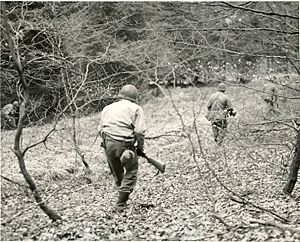Operation Stösser facts for kids
Quick facts for kids Operation Stösser |
|||||||
|---|---|---|---|---|---|---|---|
| Part of the Battle of the Bulge during World War II | |||||||
|
|||||||
| Belligerents | |||||||
| Commanders and leaders | |||||||
| Friedrich August Freiherr von der Heydte (POW) | George A. Smith (Jr.) | ||||||
| Units involved | |||||||
| 1,200–1,300 Fallschirmjäger | 18th Infantry Regiment | ||||||
| Casualties and losses | |||||||
| Unknown | Unknown | ||||||
Operation Stösser (which means "Operation Hawk" in English) was a secret German plan during World War II. It involved dropping paratroopers (soldiers who jump from planes) behind American lines. This happened in the High Fens area during the famous Battle of the Bulge.
The main goal was to capture and hold an important crossroads at Belle Croix. This spot was key because two major supply roads met there. These roads were vital for moving supplies and troops. The German plan was to hold the crossroads until the 12th SS Panzer Division arrived. The operation was led by a German officer named Friedrich August Freiherr von der Heydte. However, many of the paratroopers and pilots were not well-trained. In the end, the mission was a failure.
Contents
Planning the Operation

Friedrich August Freiherr von der Heydte was a very experienced paratrooper commander. He had fought in many battles, including the airborne attack on Crete. On December 8, 1944, he was called in and told to get ready for a secret mission. He had only eight days to prepare.
Heydte wanted to use his own well-trained soldiers. But this was not allowed. The German command worried that moving his unit might warn the Allies about their big attack. Instead, he was given about 800 men from different units. These soldiers were often less experienced or had caused problems before. Heydte couldn't argue much because he was related to a man who tried to assassinate Hitler.
However, about 150 soldiers from Heydte's own unit secretly joined him. They did this out of loyalty. To keep the mission a secret, the Germans decided not to do any scouting or take aerial photos before the drop.
Lack of Training and Resources
The soldiers had very little time to get to know each other or train together. Many of the men assigned to Heydte had never even jumped from an airplane before. Heydte later said that he had never commanded a unit with less fighting spirit.
On December 13, Heydte visited his commanders to complain. He felt he didn't have enough resources for the mission to succeed. Field Marshal Walter Model told him that the entire Ardennes Offensive (the larger attack) had less than a 10 percent chance of working. But Model said they had to try, calling it "the last chance to conclude the war favorably."
The Difficult Drop
The paratrooper drop was supposed to happen earlier but was delayed by a day. The new time was set for 3:00 AM on December 17. The drop zone was about 7 miles north of Malmedy. The goal was to capture the crossroads and hold it for about 24 hours. This would stop Allied reinforcements and supplies from moving through the area.
Just after midnight on December 17, 112 German transport planes took off. They carried about 1,300 paratroopers. A powerful snowstorm was raging, with strong winds and thick clouds. The German air force (Luftwaffe) didn't have many experienced pilots left. Many pilots had never flown the Ju 52 transport plane before. Half of them had never flown in combat. They also weren't trained to drop troops at night or fly in formation.
Many planes flew off course because of the bad weather and inexperienced pilots. About 250 men were dropped near Bonn, which was 50 miles away from where they were supposed to land. Some planes even landed with their troops still inside. Strong winds blew many paratroopers far from the intended drop zone. Their landings were also much rougher. Only a small part of the force landed anywhere near the correct area. Many inexperienced German paratroopers were badly hurt or died when they landed. Some were not found until the snow melted the following spring.
Confusion and Withdrawal
Because the German paratroopers were scattered so widely, reports of them came from all over the Ardennes. This made the Allies think a much larger German paratrooper attack had happened. It caused a lot of confusion for the Americans. They sent many soldiers to secure their rear areas instead of focusing on the main German attack at the front. An entire U.S. infantry regiment (about 3,000 men) and an armored unit (300 tanks and 2,000 men) spent several days searching for the German force.
By noon on December 17, Heydte's unit had gathered about 300 soldiers. They had very little ammunition. This small group was too weak to capture the crossroads on their own. Heydte first planned to wait for the 12th SS Panzer Division to arrive. But that division never made it, as they were stopped by American forces.
After three days of waiting, Heydte changed his plan. He decided to focus on gathering information instead. However, his radios were broken during the drop, so he couldn't report what he learned.
With only one day's food and limited water, Heydte decided to lead his forces back toward German lines on December 19. They used their remaining ammunition to attack the rear of American lines. Only about one-third of his men made it back to German territory. Heydte himself was wounded, suffered from frostbite, and had pneumonia. He eventually found a German family in Monschau. The next morning, he sent a boy with a surrender note to the Allies. He was taken prisoner on December 23 and remained in custody until 1947.


